
Sumba, natively also spelt as Humba, Hubba, Suba, or Zuba is an Indonesian island located in the Eastern Indonesia and administratively part of the East Nusa Tenggara provincial territory. Sumba has an area of 11,243.78 square kilometres, about the same size as Jamaica or Hawaii (Island). The population was 686,113 at the 2010 Census and 779,049 at the 2020 Census; the official estimate as of mid-2023 was 820,506. To the northwest of Sumba is Sumbawa, to the northeast, across the Sumba Strait, is Flores, to the east, across the Savu Sea, is Timor, and to the south, across part of the Indian Ocean, is Australia.

Timor is an island at the southern end of Maritime Southeast Asia, in the north of the Timor Sea. The island is divided between the sovereign states of East Timor on the eastern part and Indonesia on the western part. The Indonesian part, known as West Timor, constitutes part of the province of East Nusa Tenggara. Within West Timor lies an exclave of East Timor called Oecusse District. The island covers an area of 30,777 square kilometres. The name is a variant of timur, Malay for "east"; it is so called because it lies at the eastern end of the Lesser Sunda Islands. Mainland Australia is less than 500 km away, separated by the Timor Sea.

Seram is the largest and main island of Maluku province of Indonesia, despite Ambon Island's historical importance. It is located just north of the smaller Ambon Island and a few other adjacent islands, such as Saparua, Haruku, Nusa Laut and the Banda Islands.

Wallacea is a biogeographical designation for a group of mainly Indonesian islands separated by deep-water straits from the Asian and Australian continental shelves. Wallacea includes Sulawesi, the largest island in the group, as well as Lombok, Sumbawa, Flores, Sumba, Timor, Halmahera, Buru, Seram, and many smaller islands. The islands of Wallacea lie between the Sunda Shelf to the west, and the Sahul Shelf including Australia and New Guinea to the south and east. The total land area of Wallacea is 347,000 km2 (134,000 sq mi).

Ujung Kulon National Park is a national park at the westernmost tip of Java, located in Sumur District of Pandeglang Regency, part of Banten province in Indonesia. It once included the volcanic island group of Krakatoa in Lampung province, although current maps has suggested the Krakatoa island group as its own protected area, the Pulau Anak Krakatau Marine Nature Reserve.

The black-naped monarch or black-naped blue flycatcher is a slim and agile passerine bird belonging to the family of monarch flycatchers found in southern and south-eastern Asia. They are sexually dimorphic, with the male having a distinctive black patch on the back of the head and a narrow black half collar ("necklace"), while the female is duller with olive brown wings and lacking the black markings on the head. They have a call that is similar to that of the Asian paradise flycatcher, and in tropical forest habitats, pairs may join mixed-species foraging flocks. Populations differ slightly in plumage colour and sizes.

The citron-crested cockatoo is a medium-sized cockatoo with an orange crest, dark grey beak, pale orange ear patches, and strong feet and claws. The underside of the larger wing and tail feathers have a pale yellow color. The eyelid color is a very light blue. Both sexes are similar. Females have a copper colored eye where as the male has a very dark black eye.

The yellow-crested cockatoo also known as the lesser sulphur-crested cockatoo, is a medium-sized cockatoo with white plumage, bluish-white bare orbital skin, grey feet, a black bill, and a retractile yellow or orange crest. The sexes are similar.

The pheasant pigeon is a species of large terrestrial pigeon. It is the only species of the monotypic genus Otidiphaps. The pheasant pigeon is found in the primary rainforests of New Guinea and nearby islands. It ranges primarily over hilly and lower mountain areas, but can also be found in lowlands.

The fauna of Indonesia is characterised by high levels of biodiversity and endemicity due to its distribution over a vast tropical archipelago. Indonesia divides into two ecological regions; western Indonesia which is more influenced by Asian fauna, and the east which is more influenced by Australasian species.

Sumba hornbill, or known natively as Julang is a large bird belonging to the family of Bucerotidae, endemic and native to the Indonesian island of Sumba. The scientific name commemorates British colonial administrator and zoological collector Alfred Hart Everett.
William Doherty was an American entomologist who specialised in Lepidoptera and later also collected birds for the Natural History Museum at Tring. He died of dysentery while in Nairobi.

Manupeu Tanah Daru National Park is located on the island of Sumba in Indonesia. This national park consists lowland forests on steep slopes that rise up to ca. 600m.
The least boobook, also known as the little Sumba hawk-owl or little Sumba boobook, is a species of owl in the family Strigidae. It is endemic to the Indonesian island of Sumba. Its natural habitat is subtropical or tropical moist lowland forests. It is threatened by habitat loss.

The celestial monarch is a species of bird in the family Monarchidae, and one of the most attractive of all the monarch flycatchers, with its spectacular blue crest and large greenish-yellow wattle. It is endemic to the Philippines with its extant range being in Luzon, Samar, Mindanao Tawi-Tawi and Basilan and it being possibly extinct on Negros and Sibuyan Island. It is often observed in mixed flocks with other birds such as blue fantails, rusty-crowned babblers, rufous paradise flycatchers, both short-crested monarchs and black-naped monarchs and other small forest birds. Its natural habitat is tropical moist lowland forests up to 750 masl. It is one of the most sought after birds by birdwatchers in the Philippines and in the world.
The white-naped monarch is a species of bird in the family Monarchidae. It is endemic to Indonesia, where it occurs in the Maluku Islands. Its natural habitat is subtropical or tropical moist lowland forests.
The Sumba myzomela is a species of bird in the family Meliphagidae. It is endemic to Sumba in the western Lesser Sunda Islands of Indonesia, where it is found in forest with a significant component of deciduous trees.

Manusela National Park is located on Seram island, in the Maluku archipelago of Indonesia. It is made up of coastal forest, swamp forest, lowland and montane rainforest ecosystem types. Mount Binaiya at 3,027 meters, is the highest of the park's six mountains. Seram is remarkable for its high degree of localised bird endemism. The park also includes important karst landscapes. On Mount Hatu Saka, near the coast of Saleman-Sawai, it is the Goa Hatusaka, currently the deepest cave of the whole Indonesia.

Tasitolu is a protected area on the coast of East Timor, 8 kilometres (5.0 mi) west of the capital Dili. The Tasitolu wetlands include three saline lakes, an esplanade, and a beach; it has been designated a Wetland of National Significance. Tasitolu Peace Park was designated in 2002 because of its cultural and historical importance. The Tasitolu Important Bird Area accommodates several near-threatened species. A 2004 reforestation project, which included community member participation, was funded by the national government. Subsequent to the 2006 East Timorese crisis, several hundred people sought refuge at Tasitolu's tent camp, established by the United Nations High Commissioner for Refugees. INTERFET, an Australian-led international military Peace Keeping Force governed by the United Nations, has established a base at Tasitolu.

The Sumba people are an ethnic group inhabiting Sumba Island in Indonesia, which is divided by four regencies, namely the Southwest Sumba Regency, West Sumba Regency, East Sumba Regency, and the East Sumba Regency. They refer to themselves as Tau Humba. The Sumbese have been able to retain much of their culture despite foreign influences that arrived long ago on the Lesser Sunda Islands.
















